Your search for 'barrels'
returned
1,183 results.
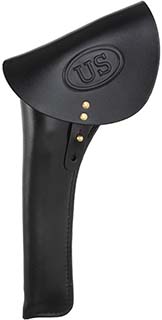
|
Military Holster, left hand, black leather, U.S. marked flap
Our Military style holster has a large top flap, embossed with "US", to completely cover your Colt or Remington .44 Army or .36 Navy revolver with up to 8" barrel. Stitched along the cut edge, with belt loop for any belt up to 3" width. A brass stud holds the closure strap. We use the conventional "butt to rear" side designation. Order a right hols
|
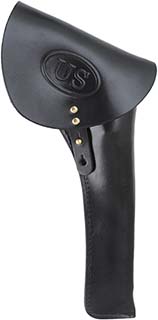
|
Military Holster, right hand, black leather, U.S. marked flap
Our Military style holster has a large top flap, embossed with "US", to completely cover your Colt or Remington .44 Army or .36 Navy revolver with up to 8" barrel. Stitched along the cut edge, with belt loop for any belt up to 3" width. A brass stud holds the closure strap. We use the conventional "butt to rear" side designation. Order a right hols
|

|
Instruction sheet and patterns for creating your own rifle inlays
Instruction sheet and patterns for creating your own firearm inlays. 3 pages, includes 69 different historic inlay designs from original Pennsylvania, Kentucky and Ohio rifles, Indian trade rifles and single and double barrel shotguns. Includes numerous cheek, wrist and wedge key inlays with animal, floral and geometric designs.
|

|
Wedge Key, tiny slanted head, slotted for capture pin, wax cast brass
This tiny wedge key measures .250" wide by .075" thick by 1.31"long beneath the head. We recommend it for use on fullstock longrifles, Hawken rifles, and Tennessee rifles with barrels up to 1" octagon. Slotted, the slanted head conforms to curved forends. Use our #KEY-60-B for a straight head version of this key for halfstocks, or forearms. Wax cas
|

|
Wedge Key, tiny slanted head, slotted for capture pin, wax cast steel
This tiny wedge key measures .250" wide b .075" thick by 1.31" long beneath the head. We recommend it for use on fullstock longrifles, Hawken rifles, and Tennessee rifles with barrels up to 1" octagon. Slotted, the slanted head conforms to curved forends. Use our #KEY-60-I for a straight head version of this key for halfstocks, or forearms. Wax cas
|

|
Wedge key , wax cast steel, extra long, slotted for capture pin
This extra long slotted wedge key key measures .325" wide by .114" thick by 1-3/4" long. As cast slot is 1/16" wide by 1-1/32". The head is slanted slightly, to fit the curvature of your big rifle's extra wide forend. Use it on 1-1/4" or wider barrels, or shorten this key as needed to fit a typical rifle.
|

|
Lee Bullet Mold .45-70 caliber, .459" diameter, 405 grain, hollow base U.S. 1873 Government mold, single cavity
This new mold, by Lee, casts an exact copy of the U. S. Model 1873 Rifle & Carbine bullet, as made by Frankfort Arsenal for the trapdoor Springfield rifle. Described in great detail, by J. Spencer Wolf, in his book Loading Cartridge for the Original 45-70 Springfield Rifle and Carbine , he discovered that modern shooters had misinterpreted the Fra
|
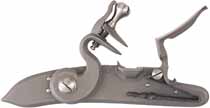
|
Early Christian's Spring, Pennsylvania Flint Lock, by Jim Chambers
Christian's Spring Flint Lock An early “Germanic" style flint lock, use it on transitional American longrifles of the 1750-1760 era. Made in the style of the Albrecht (Albright) family, of Christian's Spring, Pennsylvania. Edward Marshall's “Indian Walk" rifle is attributed to the Albrechts. Larger than Siler's large lock, it is a bit more poten
|
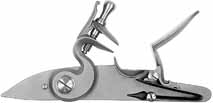
|
Early Ketland Flint Lock, by Jim Chambers
Early Ketland Flint Lock This flat faced English flint lock is made in the style of the early work of Thomas Ketland, for use on traditional American longrifles and English fowling guns of the 1750-1780 era. Unmarked, you might engrave KETLAND in block letters ahead of the cock, as many old locks were marked. A few locks also had simple floral
|
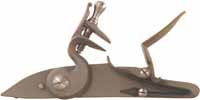
|
Early Ketland Flint Lock, with pan bridle, by Jim Chambers
Early Ketland Flint Lock This flat faced English flint lock is made in the style of the early work of Thomas Ketland, for use on traditional American longrifles and English fowling guns of the 1750-1780 era. Unmarked, you might engrave KETLAND in block letters ahead of the cock, as many old locks were marked. A few locks also had simple floral
|
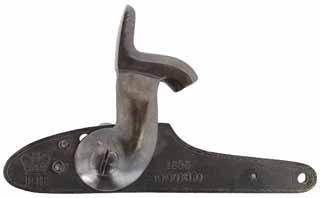
|
Enfield Rifle Lock , circa 1853 Crown P-H mark, unused, excellent
Made for use on an 1853 Enfield Rifle Musket, this new lock has been drilled for two lock bolts, but never tapped, never installed on a replica Enfield three band rifled musket. Probably made after 1979 for a replica of the Enfield Musket issued to the East India Company, the lock is finished to a dark blue. The hammer and lock plate are engraved w
|
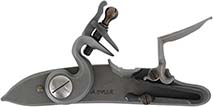
|
Flint Lock , French Tulle Fusil de Chasse , with A. TVLLE marking
Tulle, France was well known for producing the popular hunting gun for trade to American and Canadian natives, French Colonials, and hunters during the early 18th century in the North American Colony of New France. These fusil de chasse were lighter and handier than contemporary French infantry muskets, making it better suited for traveling long di
|

|
Percussion Lock, Rifle, Ohio - Goulcher , by R. E. Davis
Goulcher Percussion Lock The Goulcher family made thousands of locks. They are found on plains rifles, late longrifles, pistols and shotguns of the 1840 to 1880 era. This Goulcher lock is pre-inlet in our Vincent rifle stock. Cut for a 1/2” powder drum. The lock has an engraved hammer with 1.65” throw, for barrels from 13/16" to 1” octagon.
|
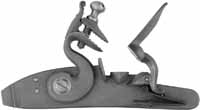
|
Late Ketland 1820 era flintlock, by R.E. Davis
Consider our late Ketland flint lock for your next Tennessee rifle, Golden Age flint longrifle, fullstock Hawken flint rifle, 1820 era English Sporting rifle, or London style late flint fowling gun. A highly refined and complex lock, this design incorporates many of the features invented by London's best gunmakers during the late flint period, prio
|
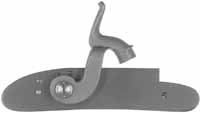
|
S. Hawken right hand, percussion lock, by L&R
Sam Hawken and other makers used these locks on Plains rifles, Ohio rifles and late longrifles, during the later percussion era of 1845 to 1885. Thomas Gibbons of St. Louis made and signed many locks. Note the square inside corner at the front of the lock plate, and the normal narrow percussion hammer, both late features. Fitted with a fly detent f
|
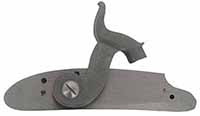
|
M. Medina Hawken right hand, percussion lock, by L&R
This L&R Lock Company M. Medina Hawken percussion lock was designed by the late Don Stith. Notice the early style rounded front edge vs. the square corner found on later locks. The lock plate also has a bit more curve from end to end than later percussion locks. The percussion hammer has cast-in engraving with a 1.8" throw. The lock plate is 4.5" l
|

|
English Durs Egg - London right Flint Lock, by L&R
Durs Egg - London right Flint Lock Perhaps London's most innovative lock and gun maker, Mr. Durs Egg immigrated from Switzerland, setting up shop in London, the world's arms making center in his time. Actually, “Durs" was a nickname, but Mr. Egg adopted it as his own. We are glad he did. Once you have used this lock, you will never confuse the “
|
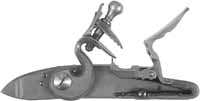
|
Jacob Dickert , right hand, flint lock by L&R
This fine lock is the correct “Germanic” style for use on classic American longrifles of the 1760 - 1800 era. Made in the style of Jacob Dickert, who worked in Lancaster county, Pennsylvania. More complex than the similar Siler lock, notice that the cock jaws point directly into the octagon pan. The unusual frizzen flange fits and seals the pan, ke
|

|
The WARRANTED right Percussion Lock, by L&R
The WARRANTED right Percussion Lock After about 1840, factory produced locks became widely available. Sometimes marked with the maker's name, often marked “Warranted", these slim percussion locks became popular on Ohio and plains rifles. Our plug and tang is made to fit a 1" octagon barrel with 3/4-16 threads. Our “Warranted" style right lock is
|